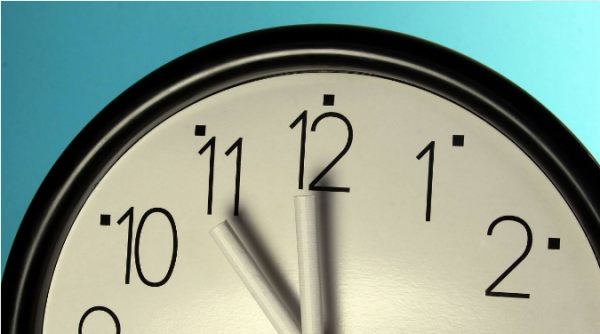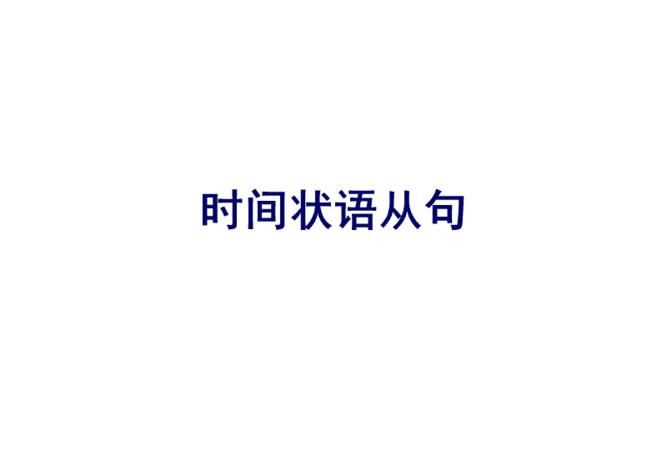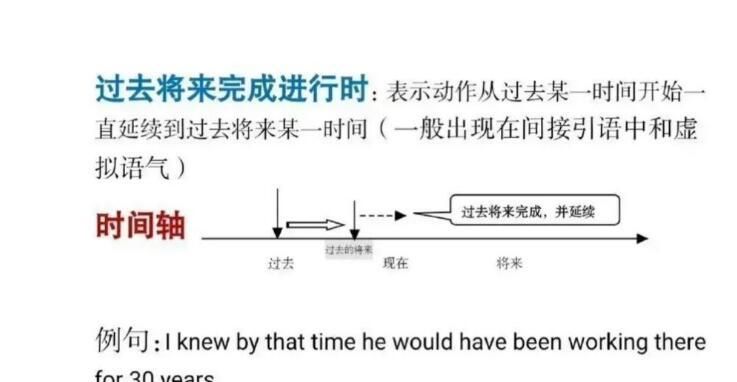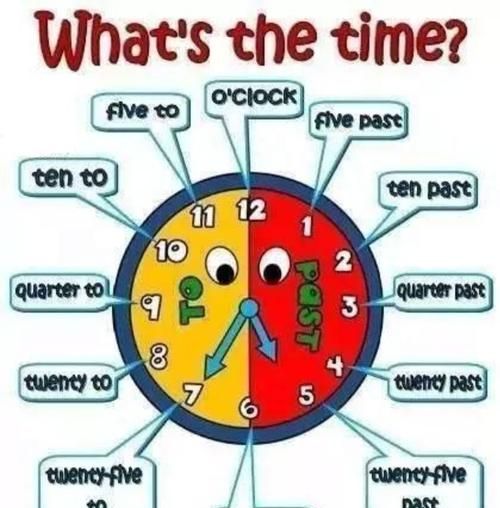本文目录
英语时间表达法
英语时间表达如下:
一.时间点的表达
1.所有的时间都可以用“小时 + 分钟”直接读:
1)6:10 six ten
2)8:30 eight thirty
3)2:40 two forty
2.如果所表述的时间在半小时之内,可以用“分钟 + past + 小时”:
1)6:10 ten past six
2)4:20 twenty past four
3)10:25 twenty-five past ten
3.如果所表述的时间在半小时之外,可以用“(相差的)分钟 + to + (下一)小时”:
1)10:35 twenty-five to eleven
2)5:50 ten to six
3)9:49 eleven to ten
4.如果所表述的时间恰好为半小时,可以用“half + past + 小时”:
1)11:30 half past eleven
2)2:30 half past two
5.如果所表述的分钟和15有关,就有三种表达法:
(15分钟又叫一刻钟:a quarter)
1)9:15 nine fifteen ; fifteen past nine ; a quarter past nine
2)3:45 three forty-five ; fifteen to four ; a quarter to four
6.整点的表达:
现在是两点整。It's two./It's two o'clock。
另外英语中的 noon 和midnight 可分别直接表示白天和夜晚的12点:
1)It's (twelve) noon。
现在是中午十二点。
2)It's (twelve) midnight。
现在是半夜零点。
7.大约时间:
1)It's almost two。
马上到两点了。
2)It's not quite two。
还不到两点。
3)It's just after two。
刚过两点。
8.若想表明是上午,可在时间后加上a.m。
如:thirteen past six a.m。(上午六点十三分)。
若想表明是下午,可在时间后加上p.m。
如:four o'clock p.m。(下午四点)。
9.句子范例:
1)It's nine forty-five。=It's a quarter to ten。
现在是九点四十五分。
2)It's two seventeen。=It's seventeen past two。
现在是两点十七分。
3)It's three。=It's three o'clock。
现在是三点。
4)It's nine thirty。=It's half past nine。
现在是九点半。
5)It's six fifteen。=It's a quarter past six。
现在是六点十五分。
6)It's three fifty。=It's ten to four。
现在是三点五十。
二.世纪、年代、年、月、日的表达
1.世纪:
1)用“定冠词+序数词+century”表示
例:在十七世纪 写作:in the 17th century,读作:in the seventeenth century
2)用“定冠词+百位进数+s”表示
例:在十七世纪 写作:in the 1600s,读作:in the sixteen hundreds
注意:这种情况下,实际表达的世纪数是阿拉伯数字本身加一。
2.年代
用“定冠词+(世纪百位进数+十位年代数)+s”表示
例:在二十世纪三十年代 写作:in the 1930s,读作:in the thirties of the twentieth century或 in the nineteen thirties
表示某年代的早期、中期和晚期,可以在定冠词后添加early, mid-和late
例如:
在二十世纪二十年代早期 in the early 1920s
在二十世纪五十年代中期 in the mid-1950s
3.年月日
1)年份
①读年份时一般分为两个单位来读,前两个数为一个,后两个数为一个:
1949 读作:nineteen forty-nine或nineteen hundred and forty-nine
② 如果是三位数,先读第一位,再把后两个数合起来读:
253 读作:two fifty-three或two hundred and fifty-three
③ 另外: 2000 读作:two thousand,1902 读作:nineteen hundred and two或 nineteen o two
④ 如果要使用year,year放在数词之前
例如:in the year two fifty-three B.C.在公元前253年
2)月份
月份是专有名词,除了少数几个月份外都有缩写形式:
January - Jan 一月
February - Feb 二月
March - Mar 三月
April - Apr 四月
August - Aug 八月
September - Sept 九月
October - Oct 十月
November - Nov 十一月
December - Dec 十二月
注意:缩写形式后面的点不能省略,因为它是表示缩写形式的符号。
3)日期:
用序数词表示
例:十月一日 写作:October 1, October 1st, 1 October, 1st October, (the) 1st of October等,其中的October都可以写成缩写形式Oct.
读作:October the first或the first of October
4)年月日
用英语表达年月日的顺序:
① 月日年
例:2002年1月17日
写作:January 17(th), 2002或January seventeenth, 2002(日和年之间需用逗号隔开)
读作:January the seventeenth, two thousand and two
②日月年
例:2002年1月17日
写作:17(th) January, 2002或the seventeenth of January, 2002(月和年之间需用逗号隔开)
读作:the seventeenth of January, two thousand and two
4. 介词的使用:
若指在哪一年或哪一月,用介词in;若具体到某一天,需用介词on。
例如:
1)She was born in 1989。
她出生于1989年。
2)She was born in August。
她出生于八月。
3)She was born in August 1989。
她出生于1989年8月。
4)She was born on 2nd August, 1989。
她出生于1989年8月2日。

扩展资料
在英语中年月日的读法和写法
一.年份
关于四位数年份的读法有下列几种情形:
1.一般情况下,将表示年份的四个数字按前后分为两组,每一组的数字都按基数词来读。
1865年读作 eighteen sixty-five
1998年读作 nineteen ninety-eight
2.如果是整百的年,后面的两个“零”读为 hundred。
1900年读作 nineteen hundred
1800年读作 eighteen hundred
3.十位数字上为“零”,该“零”读为字母 O 的发音。
1809年读作 eighteen O nine
4.关于千年的一些读法。
2000年读作 two thousand
2008年读作 two thousand and eight 或 O eight
2017年读作 two thousand and seventeen 或 two thousand seventeen
5.三位以内数字的年份,一般是按照基数词的方法来读。
531 BC 读作 five hundred (and) thirty-one BC
二.日期
日期的写法可以采用基数词和序数词两种形式。
例如: March 1也可以写成March 1st;May 29也可以写成May 29th。但是,日期的读法只能用序数词的形式。
例如:
October 31(October 31st)读作October(the)thirty-first
August 26(August 26th)读作August(the)twenty-sixth
注意:通常情况下,the 是不读出来的。
1.朗读方面
在朗读时,"月份"一般直接用英语读出;"日"则要读成"the 序数词";年份,一般分为两个单位来读,前两个数为一个单位,后两个数为一个单位。
1982 年读作 nineteen eighty-two, 1900 年读作 nineteenhundred。
如果是三位数,先读第一位,再把后两个数合起来读。
如:984 年可读为 nine eighty-four,757 年读成 sevenfifty-seven。
另外,像 2000 年一般读成 two thousand, 2001 年则读成 two thousand and one,以此类推,2004 年应读成 two thousand and four 或者 two thousand four (通常情况下“and”不读出来)。 January 12th, 1993 读成 January (the)twelfth, nineteen ninety-three。
2.书写方面
先看下面的两个例子:
1.1986 年 10 月 23 日→October 23, 1986/October 23rd, 1986
2.2002 年 1 月 17 日→January 17, 2002/January 17th, 2002
三.英美时间表达之不同
日期的表示法英国和美国稍有不同,英国通常表示为“日—月—年”,美国通常表示为“月—日—年”。如“10月10日”可表示为 October 10,1985(美)或10(th)October, 1985(英)。
注意:最好避免把整个日期都写成数字, 这在英美语中表示的含义并不相同:如“2. 7. 97”、“2-7-97”、“2/7/97”这类表达,在美国英语中表示“1997年2月7日”,而在英国英语中则表示“1997年7月2日”。
英语中时间做什么成分
在英语语法当中。表示时间的词一般充当的都是状语。不管是大时间还是小时间。at three o'clock在三点钟,如果出现在句子里,就是时间状语。还有其他的时间状语从句,例如像when引导的。程度副词在句子里也是做状语的,只不过大多数修饰的是谓语动词。

英语初中全部语法
(1)一般现在时
基本形式(以do为例):
第三人称单数:does(主语为非第三人称单数);
肯定句:主语+动词原形+其他;
He
works for us.
否定句:主语+don‘t/doesn't+动词原形+其他;
He
doesn't work for us.
一般疑问句:Do/Does+主语+动词原形+其他。
肯定回答:Yes,(+ 主语+do/does).
否定回答:No,(+主语+don't/doesn't.)
特殊疑问句:疑问词+一般疑问句语
Does
he work for us?
Yes,
he does.
No,
he doesn't
What
does he do for us?
He
works for us.
(2)一般过去时
be动词+行为动词的过去式
否定句式:在行为动词前加didn‘t,同时还原行为动词,或was/were+not;
was或were放于句首;用助动词do的过去式did提问,同时还原行为动词
例如: Did
he work for us?
He
didn't work for us.
He
worked for us.
(3)一般将来时
am/are/is+going to+do 或
will/shall+do
am/is/are/about
to + do
am/is/are
to + do;
一般将来时的表达方法
be
going to +动词原形
be +不定式,be to+动词原形,be
about to +动词原形
be
able to +不定式
be
about to+动词原形
will
+ 动词原形;
例如:He
is going to work for us.
He
will work for us;
He
is coming.这是特殊的用一般现在时 表达 将来时态 的例子!!
(4)过去将来时
be(was,were)going to+动词原形
be(was,were)about to+动词原形
be(was,were)to+动词原形
肯定句:主语+be(was,were)going
to+动词原形~.
否定句:主语+be(was,were)not
going to+动词原形~.
疑问句:Be(Was,Were)+主语+going
to+动词原形~?
肯定句:主语+would(should)+动词原形~.
否定句:主语+would(should)not+动词原形~.
疑问句:Would(Should)+主语+动词原形~?
He
would work for us.
(5)现在进行时
主语+be+v.ing〔现在分词〕形式(其中v表示动词)
表示现在正在进行的动作或最近在做的事。
例如:I am
buying a book.
第一人称+am+doing+sth
第二人称+are+doing
+sth (doing是泛指所有的v-ing形式)
第三人称+is+doing+sth
例:He
is working.
(6)过去进行时
肯定句:主语+was/were+doing+其它
否定句:主语+was/were+not+doing+其它
一般疑问句及答语:Was/Were+主语+doing+其它 ;答语:Yes,I主语+was/were./No,I主语+wasn't/weren't.
特殊疑问句:特殊疑问词+was/were+主语+doing+其它
He
was working when he was alive.
(7)将来进行时
主语+will
+ be +现在分词
He
will be working for us.=He will work for us.
(8)过去将来进行时
should(would)+be+现在分词
He
said that he would be working for us.=He said that he would work for us.
(9)现在完成时
基本结构:主语+have/has+过去分词(done)
①肯定句:主语+have/has+过去分词+其他
②否定句:主语+have/has+not+过去分词+其他
③一般疑问句:Have/Has+主语+过去分词+其他
④特殊疑问句:特殊疑问词+一般疑问句(have/has+主语+过去分词+其他\
He
has worked for us for ten years.
Has
he worked for us for ten years.
(10)过去完成时
基本结构:主语+had+过去分词(done)
①肯定句:主语+had+过去分词+其他
②否定句:主语+had+not+过去分词+其他
③一般疑问句:Had+主语+过去分词+其他
肯定回答:Yes,主语+had
否定回答:No,主语+hadn't
④特殊疑问句:特殊疑问词+一般疑问句(had+主语+过去分词+其他)
语法判定:
( 1 ) by + 过去的时间点。如:
I
had finished reading the novel by nine o'clock last night.
( 2 ) by the end of + 过去的时间点。如:
We
had learnt over two thousand English words by the end of last term.
( 3 ) before + 过去的时间点。如:
They
had planted six hundred trees before last Wednesday.
(11)将来完成时
(shall)will+have+动词过去分词
before+将来时间或by+将来时间
before或by the time引导的现在时的从句
He
will have worked for us.=He will work for us.
(12)过去将来完成时
should
/ would have done sth.
He
said that he would have worked for us.=He said that he would work for us.
(13)现在完成进行时
基本与现在完成时相同,但是现在完成进行时只能表示仍然持续的概念
have/has
been +-ing 分词
He
has been working for us for ten years.=He has worked for us for ten years.
(14)过去完成进行时
had
been +-ing 分词
He
said that he had been working for us for ten years.=He said that he had worked
for us for ten years.
(15)将来完成进行时
主语+
shall/will have been doing
He
will have been working for us.=He will work for us.
翻译为:他最近一直在为我们工作(过去在工作,现在在工作,将来还会工作)
(16)过去将来完成进行时
should+have
been+现在分词用于第一人称
would
have been+现在分词用于其他人称
He
said that he would have been working for us.=He said that he would work for us.
举例:
英语中有12个主要时态,都来自于三时(过去、现在、将来)
现在以I
listen为例,举例英语中有12个主要时态如下所示:
一般现在时:I listen
现在进行时:I am listening
过去进行时:I was listening
现在完成时:I have listened
现在完成进行时:I have been listening
一般将来时:I shall listen”或“I will listen.”
将来进行时:I shall be listening
一般过去时:I listened
过去完成时:I had listened
过去完成进行时:I had been listening
将来完成时: I shall have listened
将来完成进行时: I shall have been listening
解释完毕,你看可以不,可以的话,请选为满意答案。希望对你有所帮助,如有疑问,请指出!

in+一段时间与after+一段时间的区别
in
+
一段时间,表示“在多长时间以后”,用在一般将来时,且是非限制性动词。
after
+
时间点,表示“某时以后”,常用在一般将来时。
after
+
一段时间,表示“过了段时间以后”,从过去的某时算起的一段时间之后,用过去时。

以上就是关于关于时间的语法点 ,英语时间表达法的全部内容,以及关于时间的语法点 的相关内容,希望能够帮到您。

